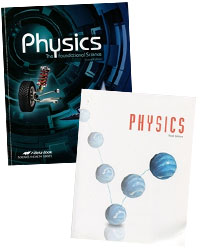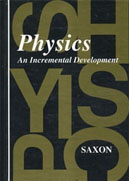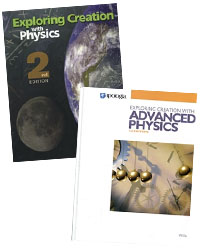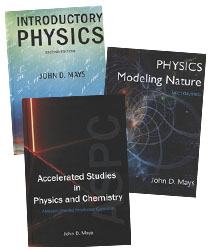Teaching physics, especially for home schoolers, can present a considerable challenge. Many factors influence the approach taken, including: aptitude of the student, background of the teacher, career interest of the student, availability of lab equipment and Christian worldview in the text, to mention a few. There is clearly no one right approach for every situation. In writing this review, I have attempted to make recommendations for a variety of situations. I hope this may be of some use to the reader.
Traditional physics texts provide a broad overview of many areas of physics, usually including the following: Mechanics, Dynamics, Thermodynamics, Sound, Fluids, Electricity and Magnetism, and Optics, which taken together comprise the study of Classical Physics; and Quantum Physics, Relativity and Nuclear Physics, which together comprise the study of Modern Physics.
 Two of the textbooks reviewed follow this format: the Bob Jones and A Beka textbooks. Interestingly, these two also include extensive Christian worldview material in the text. These are both good general textbooks, providing a good overview of the field of Physics from a Christian perspective. They are moderate in their level of difficulty, and include numerous examples drawn from modern day technology and current science issues. The Bob Jones text is more visually appealing and contains a little more in the way of current issues in physics.
Two of the textbooks reviewed follow this format: the Bob Jones and A Beka textbooks. Interestingly, these two also include extensive Christian worldview material in the text. These are both good general textbooks, providing a good overview of the field of Physics from a Christian perspective. They are moderate in their level of difficulty, and include numerous examples drawn from modern day technology and current science issues. The Bob Jones text is more visually appealing and contains a little more in the way of current issues in physics.
 The Saxon text presents the material in the typical Saxon incremental approach. If your student has done well in some of the more advanced Saxon math textbooks, then this could be an excellent choice. Rather than a sequential topical approach, such as Bob Jones, A Beka, or Novare, areas are developed slowly and simultaneously, so one does not cover an entire subject area until well into the text. It is a challenging textbook, and should provide a good preparation for college bound science majors.
The Saxon text presents the material in the typical Saxon incremental approach. If your student has done well in some of the more advanced Saxon math textbooks, then this could be an excellent choice. Rather than a sequential topical approach, such as Bob Jones, A Beka, or Novare, areas are developed slowly and simultaneously, so one does not cover an entire subject area until well into the text. It is a challenging textbook, and should provide a good preparation for college bound science majors.
The Apologia offerings present yet another approach. The Exploring Creation text addresses only the basic Classical Physics areas. Its slow, more methodical approach provides a good foundation in Physics, but lacks the breadth and pizzazz of the more traditional texts. Consider this text if the student must pretty much figure Physics out on their own (no knowledgeable teacher or mentor). It will provide a good first course for a student interested in Physics or a possible career in science. The Advanced Physics course seems to be designed for a second year course in Physics. Few homeschoolers would pursue this course (two years of Physics before college). However, if a two year high school Physics curriculum works for you, this would be an excellent choice. The first year requires minimal math, while the second year book assumes good math skills and preparation. A nice feature of these texts is that they have labs integrated in the text. The labs use a bare minimum of equipment, most of which will be available around your home. What you don’t have, you can purchase cheaply. These labs may appear simple and maybe even childish, but they illustrate significant principles. The more time you spend on them, the more benefit you will get from them.
It will provide a good first course for a student interested in Physics or a possible career in science. The Advanced Physics course seems to be designed for a second year course in Physics. Few homeschoolers would pursue this course (two years of Physics before college). However, if a two year high school Physics curriculum works for you, this would be an excellent choice. The first year requires minimal math, while the second year book assumes good math skills and preparation. A nice feature of these texts is that they have labs integrated in the text. The labs use a bare minimum of equipment, most of which will be available around your home. What you don’t have, you can purchase cheaply. These labs may appear simple and maybe even childish, but they illustrate significant principles. The more time you spend on them, the more benefit you will get from them.
 The Novare books by John Mays follow yet another strategy. The intent here is to cover less material, but to master it more thoroughly. For many students, particularly those not planning on science careers, this approach may be better. Another difference is that Mays believes in teaching Physics before the other sciences, as Chemistry and Biology build upon the foundation of Physics. I agree with Mays in this regard. In light of these goals, Mays offers three Physics text books. Introductory Physics and Accelerated Studies in Physics and Chemistry are designed to be taught to High School Freshman. The Accelerated Studies book would be suitable for students who have already had a year of algebra, and want a bit more aggressive course. It includes an introduction to Quantum Physics as background for study in Chemistry. These two texts include five experiments. Every effort should be made to complete them. For college bound science majors, Mays third text, PHYSICS Modeling Nature, provides a second course in Physics for High School Seniors. Students should have already taken Advanced Algebra and Trigonometry. It includes a chapter on Nuclear Physics for those students planning on taking college advanced placement tests. To help teachers, Mays’ Science for Every Teacher: Volume 1: Physics provides a good overview/review of the Physics curriculum content.
The Novare books by John Mays follow yet another strategy. The intent here is to cover less material, but to master it more thoroughly. For many students, particularly those not planning on science careers, this approach may be better. Another difference is that Mays believes in teaching Physics before the other sciences, as Chemistry and Biology build upon the foundation of Physics. I agree with Mays in this regard. In light of these goals, Mays offers three Physics text books. Introductory Physics and Accelerated Studies in Physics and Chemistry are designed to be taught to High School Freshman. The Accelerated Studies book would be suitable for students who have already had a year of algebra, and want a bit more aggressive course. It includes an introduction to Quantum Physics as background for study in Chemistry. These two texts include five experiments. Every effort should be made to complete them. For college bound science majors, Mays third text, PHYSICS Modeling Nature, provides a second course in Physics for High School Seniors. Students should have already taken Advanced Algebra and Trigonometry. It includes a chapter on Nuclear Physics for those students planning on taking college advanced placement tests. To help teachers, Mays’ Science for Every Teacher: Volume 1: Physics provides a good overview/review of the Physics curriculum content.
Physics Labs
 Both A Beka and Bob Jones publish lab manuals to be used with their textbooks. They are not, however, coordinated with the texts, and either lab manual may be used with any text book. The lab manuals list equipment needed, describe the experiment, provide room for recording data, and generally guide you in the analysis of the data. However, unless you intend to spend a bit of time buying the various items needed for the labs, the lab books will be of marginal value. Before buying lab manuals, you may want to look through a copy and decide if it makes sense for you.
Both A Beka and Bob Jones publish lab manuals to be used with their textbooks. They are not, however, coordinated with the texts, and either lab manual may be used with any text book. The lab manuals list equipment needed, describe the experiment, provide room for recording data, and generally guide you in the analysis of the data. However, unless you intend to spend a bit of time buying the various items needed for the labs, the lab books will be of marginal value. Before buying lab manuals, you may want to look through a copy and decide if it makes sense for you.
Having taught Physics for a number of years, I must take a moment to emphasize the importance of doing lab work. One cannot develop an appreciation of the challenges of science without engaging in an attempt to do some experimental work. Physics offers the opportunity to design experiments, perform them, take some real data, analyze, and draw some conclusions. This is the heart of science. Having said that, I know how difficult this can be. But please, take a little time to do at least a few labs.
One of the greatest problems in doing labs centers on equipment. It can be expensive. You may never use it again. You have to take time to learn to use it, then try it out. I typically devote 2-3 hours to do a lab, after I have previously played with everything and know what I am doing. Consider it a learning adventure for yourself as well as your student. Have some fun with it. Exercise some creativity. Here are some specific recommendations.
For Mechanics labs (motion, collisions) consider using a smart phone to record the action in a video. Include in the picture a yard stick, or homemade grid on butcher paper. Transfer the video to a computer and use a free program like Movie Maker (Windows 10) to view the video frame by frame, writing down the position(s) of the object(s) in each frame. Since each frame is typically 1/24th of a second, you now have all of the time and position data for analysis.
For electronics I suggest buying a cheap electronics experiment kit. Or perhaps better still, find someone in your church who knows some electronics and ask for a little advice and/or help. A little knowledge can save you a lot of money. A Volt-Ohm-Meter; a few resistors, capacitors and coils; a battery; and some wire can be enough to do many electronics experiments and measurements.
Review by Dr. John Shaw, B.A., M.S., Ph.D
Dr. John Shaw is an experienced teacher with a strong interest in Christian schools, science education in particular. After graduating from Portland State University with a B.A degree in Psychology, John went on to earn an M.S. in Electronic Science, and a Ph.D in Applied Physics, both from Oregon Graduate Institute. Currently, as the president of Shaw Technologies, Inc., Dr. Shaw provides consulting and contract "R & D" for high tech companies; he specializes in mathematical and scientific analysis and embedded computer systems. John and his wife Debbie live in Tualatin, Oregon, where he pastors a small church and they enjoy their two grown children and nine grandchildren.
Did you find this review helpful?